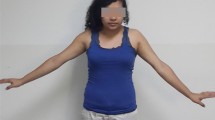Abstract
Purpose
Vertebral segmentation and fusion failures are quite common and often occur as incidental findings. These anatomical variants may be associated with deformity and lead to pain and other neurological signs. They are less frequent in the cervical spine. We report three cases of rare posterior arch segmentation failure at the cervical spine and cervicothoracic junction, with an interesting pattern of laminar arrangement.
Methods
The clinical and radiological findings of three patients with unusual anatomical variants of the posterior elements of the subaxial cervical spine and cervicothoracic junction are reported.
Results
We found various association of scoliosis, partial butterfly vertebra, absent pedicle, transverse process and lateral mass anomalies. Interestingly, we report two different and unusual laminar morphologies.
Conclusion
Congenital morphological disorders may occur at the lower cervical spine and cervicothoracic junction, and they can involve the vertebral body as well as the posterior arch. We reported three cases of uncommon malformations, with a unique Y- and S-shaped laminar pattern.



Similar content being viewed by others
References
Abduljabbar FH, Rossel F, Nooh A, Jarzem P (2015) Misdiagnosing absent pedicle of cervical spine in the acute trauma setting. Orthop Rev (Pavia) 7(3):5889
Basu PS, Elsebaie H, Noordeen MH (2002) Congenital spinal deformity: a comprehensive assessment at presentation. Spine (Phila Pa 1976) 15(20):2255–2259
Bernard TN Jr, Burke SW, Johnston CE, Roberts JM (1985) Congenital spine deformities. A review of 47 cases. Orthopedics 8(6):777–783
Dias MS (2007) Normal and abnormal development of the spine. Neurosurg Clin N Am 18(3):415–429
Goodwin CR, Desai A, Khattab MH, Elder BD, Bydon A, Wolinsky JP (2016) Cervical fusion for absent pedicle syndrome manifesting with myelopathy. World Neurosurg 86:515.e17–515.e22
Guille JT, Sherk HH (2002) Congenital osseous anomalies of the upper and lower cervical spine in children. J Bone Joint Surg Am 84(2):277–288
Sahoo SK, Salunke P (2018) C2 Body as “Keystone” in management of C1-C2-C3 dislocation secondary to congenital absence of C2 posterior elements. World Neurosurg 110:117–120
Sharifi G, Lotfinia M, Rahmanzade R, Lotfinia AA, Rahmanzadeh R, Omidbeigi M, Meybodi ET (2018) Congenital absence of the posterior element of C1, C2, and C3 along with bilateral absence of c4 pedicles: case report and review of the literature. World Neurosurg 111:395–401
Standring S (2015) Gray’s anatomy, the anatomical basis of clinical practice. Elsevier, New York
Wiener MD, Martinez S, Forsberg DA (1990) Congenital absence of a cervical spine pedicle: clinical and radiologic findings. Am J Roentgenol 155(5):1037–1041
Yun DJ, Hwang BW, Kim DJ, Lee SH (2016) An upper and middle cervical spine posterior arch defect leading to myelopathy and a thoracic spine posterior arch defect. World Neurosurg 93:489.e1–489.e5
Acknowledgements
No funding was received for this study.
Author information
Authors and Affiliations
Contributions
AR: Project development, Data Collection and Analysis, Manuscript writing; GM: Project development, Manuscript editing.
Corresponding author
Ethics declarations
Conflict of interest
The authors report no potential conflicts of interest concerning this scientific material.
Informed consent
The informed consent was obtained for anonymous publication of patients’ clinical data.
Rights and permissions
About this article
Cite this article
Rusconi, A., Maestretti, G. Segmentation failure of the posterior elements at the cervical spine and cervicothoracic junction: report of three cases. Surg Radiol Anat 40, 1379–1382 (2018). https://doi.org/10.1007/s00276-018-2093-2
Received:
Accepted:
Published:
Issue Date:
DOI: https://doi.org/10.1007/s00276-018-2093-2




